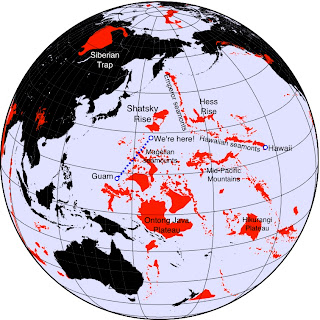
One more day, and we'll be deploying seismic gears, i.e., to be ready for a seismic survey over Shatsky Rise. In case you've just started to follow this blog lately, I'd like to explain (briefly) why we're taking so much pain to get to this place called Shatsky Rise. First of all, there are some unusual regions called "Large igneous provinces" on this planet, which are highlighted by red in the map shown here. These provinces have very thick crust, meaning that they are products of intensive volcanic activities in the past. The western Pacific is particularly loaded with quite a few massive oceanic plateaus such as Ontong Java Plateau, Shatsky Rise, and Hess Rise, all of which are classified as large igneous provinces. One of the biggest problems in earth sciences right now is why and how these provinces are formed. Shatsky Rise, for example, is as big as the state of California, and geologically speaking, it was formed nearly instantly. The scale of volcanism is thus much more substantial than our familiar volcanoes. The formation of these oceanic plateaus represents extreme events in Earth's history, but nobody is sure why we have such things to begin with. Of course, we have hypotheses and speculations, and people are debating endlessly who is right, but here's a fact: we just don't have good enough data to test any hypothesis with confidence.
So, this is why we're sailing to Shatsky Rise and get some deeply-penetrating seismic data, which will help us distinguish between various ideas. But wait a minute. Why did we choose to study Shatsky, instead of other plateaus? We have several good reasons, and one of them is that we already know that the rise was formed at a ridge-ridge-ridge triple junction (situations about other plateaus are much more ambiguous). If you don't know about this geological jargon, don't worry. In this context, it just means that this special geological setting allows us to interpret seismic data in a very simple way. Getting clear-cut data is vital, especially when people have been debating for so many years.
Isn't Shatsky's Rise associated with super volcanism?
ReplyDeleteI think "super volcano" is a term coined by recent journalists (BBC, perhaps), and we don't normally use it... Many large igneous provinces can be said to be super-volcanoes; that is, they are pretty much synonymous.
DeletePerhaps:
DeleteHess rise
Hikurangi province
Magellan seamounts
Mid-Pacific seamounts
Ontong-Java province
all erupted about the same time, in the early Cretaceous c.125 Mya. Perhaps the entire ensemble formed a vast super-province, atop a super-plume, which melted through the overlying crust, in various places, to varying degrees ("seamounts to provinces in size"). Cp. Tharsis Bulge on Mars, whereat a super-plume of (Martian) mantle material bulged out the crust, and melted through in several places, producing several massive shield volcanoes, e.g. Olympus Mons.
The "Marshall - Ellice (Tuvalu) - Louisville" seamount chain points to the Louisville Hot-Spot. The "Line - Tuamoto" seamount chains point to the MacDonald Hot-Spot. The "Cook - Australo" seamount chains point to the Easter Hot-Spot. Thus, perhaps a super-plume produced a super-province of flood basalts, in the southeast paleo-Pacific ocean, c.125 Mya? Perhaps said super-plume somehow relates to the birth of the Pacific plate, emerging between the Farallon (east), Phoenix (south), and Izanagi (north) oceanic plates?
IMAGES:
-------
http://ars.els-cdn.com/content/image/1-s2.0-S1342937X11003613-gr8.jpg
http://imageshack.us/photo/my-images/703/pacificigneoussuperprov.jpg/
SOURCE:
-------
http://www.sciencedirect.com/science/article/pii/S1342937X11003613